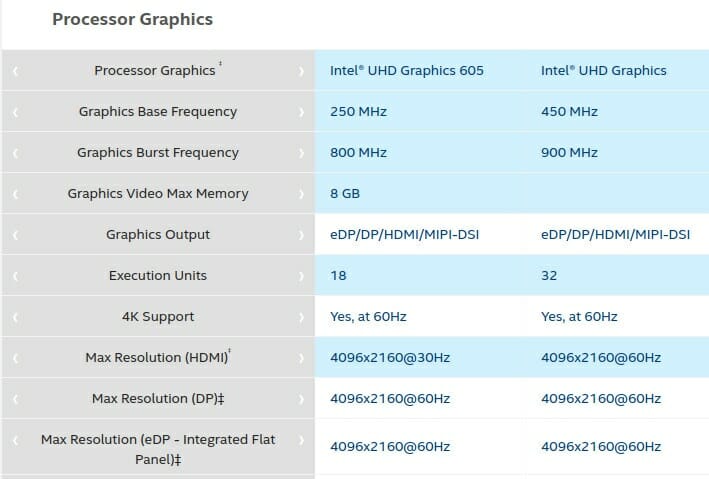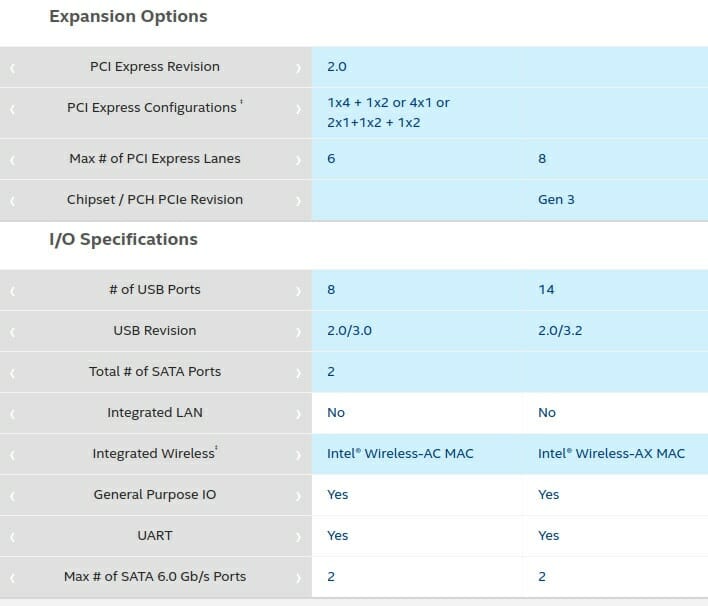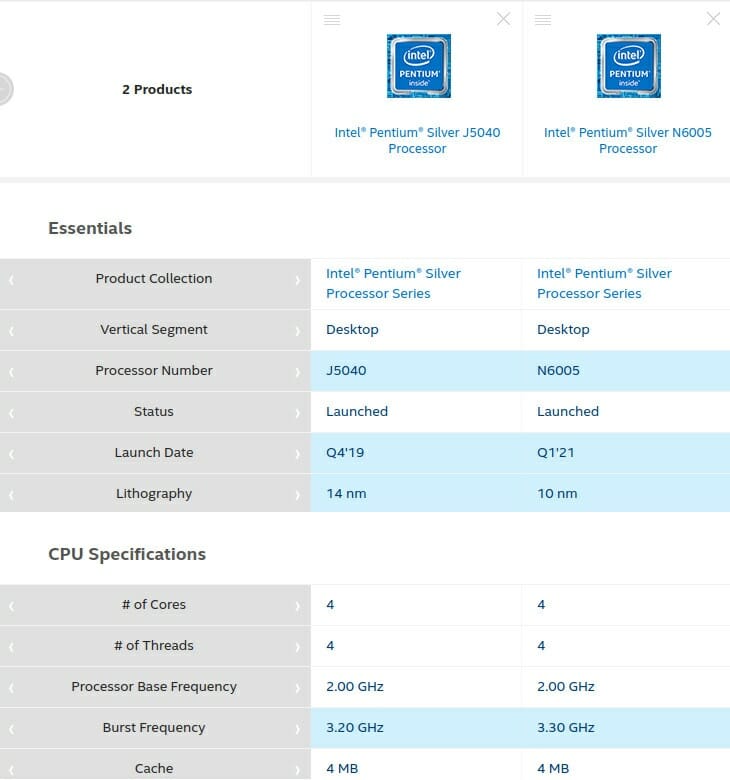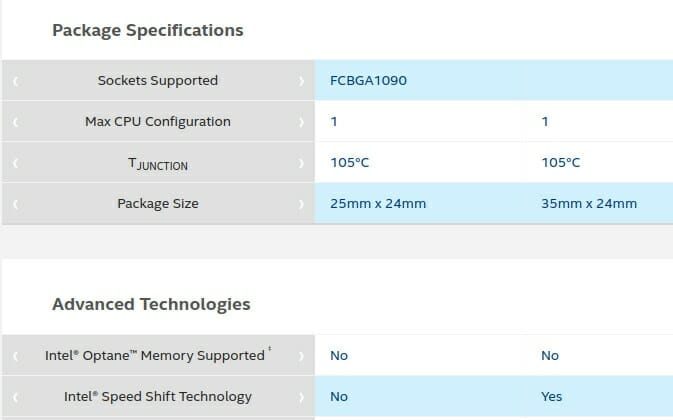Intel has finally announced the Gemini Lake processor family successor at CES 2021 together with other processors. The Jasper Lake family currently comes with six different Celeron and Pentium Silver parts with respectively 6W and 10 TDP.
The company positions those for the education market, but I’d expect them to also be found in various mini PCs, single board computers, and systems-on-module. The processors are manufactured with the company’s 10nm process, and are said to deliver up to 35% better overall application performance and up to 78% better graphics performance compared to Gemini Lake Refresh processors.
The new parts listed on Ark are not really new for CNX Software readers as we published the list of Jasper Lake processors in September following a leak.
| Core / Thread | Base / Boost Frequency | TDP | |
|---|---|---|---|
| Pentium Silver N6005 | 4C/4T | 2.0GHz / 3.3GHz | 10W |
| Celeron N5105 | 4C/4T | 2.0GHz / 2.9GHz | 10W |
| Celeron N4505 | 2C/2T | 2.0GHz / 2.9GHz | 10W |
| Pentium Silver N6000 | 4C/4T | 1.1GHz / 3.1GHz | 6W |
| Celeron N5100 | 4C/4T | 1.1GHz / 2.8GHz | 6W |
| Celeron N4500 | 2C/2T | 1.1GHz / 2.8GHz | 6W |
But we know have more details, so let’s compare the top parts of both Gemini Lake Refresh (Pentium Silver J5040) and Jasper Lake (Pentium Silver N6005) both 10W processors.
One of the main differences is the new 10nm process, as Gemini Lake was based on a 14nm process. The number of cores and frequency are pretty much identical, except for a slightly higher burst frequency. It should be noted that while Gemini Lake processors relies on Goldmont Plus microarchitecture, Jasper Lake makes use of the new Tremont microarchitecture.
In theory, Jasper Lake processors will support larger capacity memory, but as we’ve seen in the past Gemini Lake based systems can handle up to 32GB RAM in dual-socket configuration (2x 16GB). One example is ODROID-H2+ SBC, so I suspect we may eventually find out Jasper Lake platforms could support up to 64GB. We just don’t know at this stage.
 The large boost in graphics performance announced by Intel is not surprising when we look at the specs, as the Intel UHD Graphics comes with 32 execution units both the base and burst frequencies are higher. It also looks like Jasper Lake will support 4Kp60 HDMI output natively, so a separate chip may not be needed anymore.
The large boost in graphics performance announced by Intel is not surprising when we look at the specs, as the Intel UHD Graphics comes with 32 execution units both the base and burst frequencies are higher. It also looks like Jasper Lake will support 4Kp60 HDMI output natively, so a separate chip may not be needed anymore.
 The Intel Pentium Silver N6005 processor will also offer more expansion and I/O with up to 8 PCI Express Gen3 lanes, and 14 USB 2.0/3.2 interfaces.
The Intel Pentium Silver N6005 processor will also offer more expansion and I/O with up to 8 PCI Express Gen3 lanes, and 14 USB 2.0/3.2 interfaces.
All those extra ports mean the processor will still be bigger at 35x 24mm despite the new 10nm process. Both Jasper Lake and Gemini Lake comes with the same “advanced technology” except for Intel Speed Shift. The feature enables the processor to directly control Turbo boost instead of relying on the OS according to an article on AnandTech. This allows the processor to reach the Turbo frequency faster and makes the system feel more responsive to the user.
I could not find announcements of Jasper Lake products right now, but considering Ark marks the processor as “Launched” as opposed to “Announced” it should not take too long.

Jean-Luc started CNX Software in 2010 as a part-time endeavor, before quitting his job as a software engineering manager, and starting to write daily news, and reviews full time later in 2011.
Support CNX Software! Donate via cryptocurrencies, become a Patron on Patreon, or purchase goods on Amazon or Aliexpress. We also use affiliate links in articles to earn commissions if you make a purchase after clicking on those links.







> up to 8 PCI Express lanes
…that are twice as fast (Gen3 instead of Gen2 speeds). BTW: you might want to retouch the table image with the 1st occurrence of (missing) 2 SATA ports since they’re not gone. And there’s a ‘N5040’ in the text that should read ‘J5040’.
Hopefully they will come for a reasonable price. I look forward to replace my current j3455 motherboard with one with this processor.
Lets hope that new boards will have PCIE conector + M.2 for NVME SSD
as J5040 don’t allow such a configuration 🙁
I bought this board asrock-j5040
https://www.alza.sk/EN/asrock-j5040-itx-d6223560.htm
I was really surprised that new board don’t have N.2 for SSD 🙁
As this is pure garbage intel 🙁
> PCIE conector + M.2 for NVME SSD as J5040 don’t allow such a configuration
Of course it does, you just need to find a board making better use of the few PCIe lanes. 😉
Your board provides two additional SATA ports via an onboard ASM1061 eating up one PCIe lane. Since GbE, the x1 PCIe slot and the M.2 key E slot use another 4 lanes there’s just one lane left with Gemini Lake on such a board.
>As this is pure garbage intel
do you really need nvme in low powered SOC? isnt it overkill?
it is a potato SOC for light task, nothing more,
and without ecc ram, its not even a viable work server, its only for simple home server.
I can assure you these are not like cherry trail, which are indeed garbage.
I was very reluctant with these like you, but after reading a lot about them I bought an intel NUC with the J5005 through a local reseller discount, I added 2x4GB DDR4 2400Mhz and one simple SSD of 250Gb and I can tell you it is a quite competent computer. A server with that CPU would need a different case with more ports for SSD/HDD, that’s for sure, but as a general purpose computer is totally valid. I use it with Linux and I can’t be more happy with it, I can’t imagine upgrading it with one of these. A NUC with a N6005 paired with 2×4 or 2×8 2933Mhz modules and a good SSD could become a nice steambox for playing most of steam games, as well as a retro emulation box 🙂
Finally Celerons is moving into 10mm node.
took them long enough.
Now just waiting wait another 6 month to get cheap low power x86 laptops to be available.
Though, these CPUs sometimes land on overpriced laptop. Many here bought N3050, 2GB/500GB laptop for ~350.
Its outdated pricing model IMO
then its the atom pc are the cheapest and N3050 is a step up in price from atom.
Current celeron prices are at atom prices in the past,
my home Jellyfin/media server celeron N4000 2GB/500GB cost ~200USD bought early last year.
Work digital signage Beelink Gemini-M N4125 8GB/120GBssd just bught in 2month ago for ~200USD.
its been dropping over the years.
These still likely won’t support HDR, core i3 or higher will likely still be needed.
Intel’s graphics non-naming scheme is so annoying.
AnandTech says it’s Gen11. I think that means HDR is supported.
The graphics performance seems like the real winner here, at least in the top SKU comparison.
CPU clock speeds barely changed despite the node shrink. Will power consumption drop?
Package size increased 40%.
My understanding is that base clocks don’t change, and since burst speed barely does the difference could possibly be the amount of time burst will work under stress, or the burst speed the CPU can sustain 100% of the time, which will clearly be higher than the (J-N)5040, and that makes the difference, as the iGPU is really useless in that range because none of them can be used to play anything with med settings at 720p other than games released +10 years ago. The VPU could be the only thing interesting though.
as a long celeron user, cpu burst speed is critical in these low end cpu, especially during heavy browsing or running alot containers. Since TDP is low, its easy to maintain full burst speed for extended time with stock cooler.
i cant say that on my gaming rig, stock cooler is not enough on these.
i agree intel iGPU can only be used for simple games & emulator, and i always wonder why do people try to use it on modern games (other than trying on in for fun and see what performance you can get).
yes VPU noteworthy for its low power decoding & transcoding, like jellyfin server